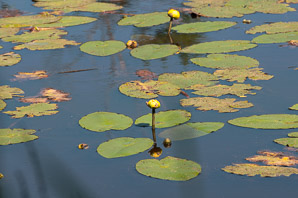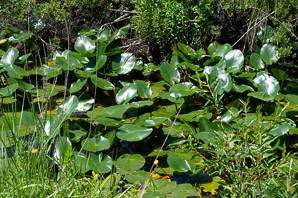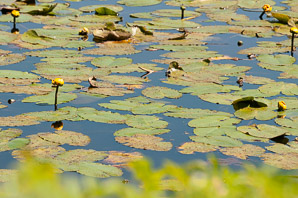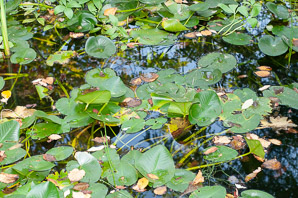
|
Nuphar lutea (L.) Sm. Yellow pond lily, spatterdock
Pond lilies are North American natives, also found in Eurasia. The genus Nuphar contains several similar species, though the exact count is a matter of interpretation. "Splitters" recognize as many as twelve species and subspecies, while "lumpers" acknowledge as few as one. Recent molecular evidence is more in favor with the splitters. The most common variety in North America is Nuphar lutea ssp. variegata. The photos here are of a somewhat less common variety, Nuphar lutea ssp. advena, sometimes called Nuphar advena. The primary difference between these two is that the former has leaves that lie flat on the water surface, while the latter has leaves that are often raised above the water surface. Identification: Pond lilies have leaves that float on or are raised a few inches above the water surface, and attractive yellow cuplike flowers on stems that poke about six inches above the surface of the water. Leaves are oval, 4-16″ (10-40 cm) around, and glossy. Underwater stems reach to roots in the water bottom. The stems convey oxygen to the roots, allowing growth in oxygen-deficient environments. Pond lilies grow in fresh, stagnant or slow-moving water that is up to 16′ (5 m) deep. Flowers are 1½-2½″ (3.8-6.3 cm) around, with six "petals" (actually sepals) and many small petals that really are petals. They flower from May to September. Edibility: The leaves, roots and seeds are edible. From Plants for a Future: Root - raw or cooked. The root can be soaked in water in order to remove a bitter taste. After long boiling, it has a taste like sheep's liver. The root can also be dried and ground into a powder then used as a thickener in soups, or can be added to cereal flours when making bread, cakes etc. Seed - raw or cooked. It can be roasted, then ground into a powder and eaten raw or used to thicken soups etc. The seed can also be toasted like popcorn. Online References:
The University of Florida IFAS Center for Aquatic and Invasive Plants (Nuphar lutea ssp. advena) Plants for a Future, a resource and information centre for edible and otherwise useful plants The Lady Bird Johnson Wildflower Center The USDA Plants Database (Nuphar lutea (L.) Sm. ssp. advena (Aiton) Kartesz & Gandhi) The USDA Plants Database (Nuphar lutea (L.) Sm. ssp. variegata (Durand) E.O. Beal) Www.wildflowersoftexas.com (Nuphar lutea (L.) Sm. ssp. advena (Aiton) Kartesz & Gandhi)
Nuphar lutea description by Thomas H. Kent, last updated 25 May 2020. © FloraFinder.org. All rights reserved. |
7/9/2012 · Nashua River Rail Trail, Groton Center, Groton, Massachusetts 6/5/2010 · Nashua River Rail Trail, Groton Center, Groton, Massachusetts 7/9/2012 · Nashua River Rail Trail, Groton Center, Groton, Massachusetts 5/22/2010 · Nashua River Rail Trail, Groton Center, Groton, Massachusetts 9/20/2009 · Wild Gardens of Acadia, Acadia National Park, Bar Harbor, Maine Range: Zones 4-10:
|







